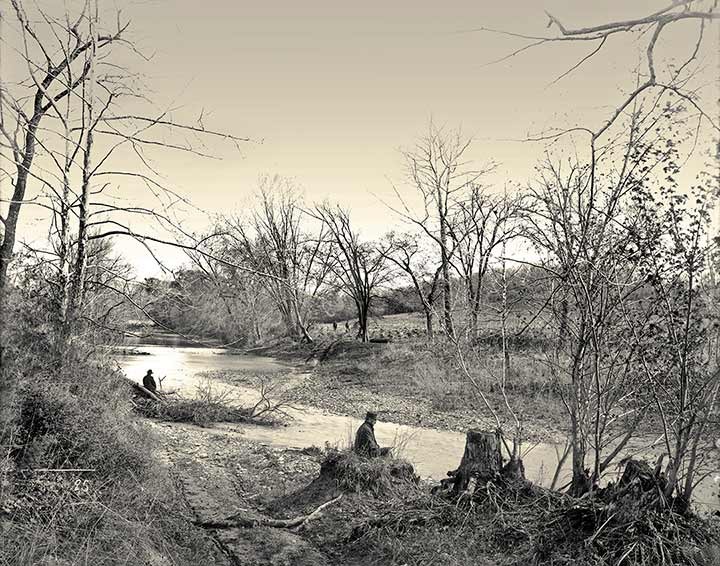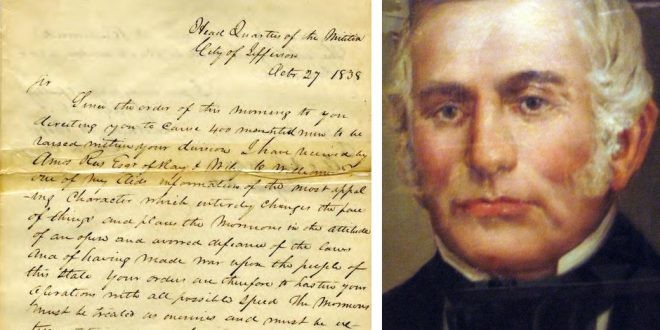The Battle of Crooked River
Introduction
Text-to-speech Audio
At this site on October 24, 1838, members of the Missouri state militia fought a skirmish with Mormon settlers. Known as the Battle at Crooked River, the skirmish proved a significant event during the larger conflict that is known as the Mormon War and took place in this part of Missouri during the late 1830s. The conflict arose from tensions between the recently-arrived Mormon settlers and the non-Mormon population who viewed the newcomers and their religion with suspicion and also resented their growing economic and potential political power in the relatively small communities this area. The Battle at Crooked River was one of several violent clashes between the two groups, and it played a key role in escalating the conflict to a larger scale. Following the skirmish, which left four men dead (three Mormon settlers and one Missouri militia member) the governor of Missouri issued Executive Order 44 which declared the Mormons "enemies" and called for their removal from the state or their extermination. Six days after the Battle of Crooked River, eighteen Mormons were hilled in the Haun's Mill massacre.
Images
Crooked River Battlefield

Missouri Executive Order 44

Backstory and Context
Text-to-speech Audio
The Battle at Crooked River was a skirmish that took place on October 25, 1838, near present-day Ray County, Missouri. The conflict involved a group of Mormon settlers and a militia group that had been assembled by Missouri Governor Lilburn Boggs to suppress the perceived threat of the Mormon community. The militia, led by Samuel Bogart, had been tracking a group of Mormons led by David W. Patten, who were believed to have stolen horses from non-Mormon settlers in the area. The Mormon settlers, who were led by David W. Patten, had set up camp at Crooked River when they were attacked by a group of Missouri state militia. The attack began with a voice calling out "who goes there?" followed by gunshots that mortally wounded one of the younger men in the Latter-day Saint militia, Pat O'Banion.
Patten ordered his militia to charge and fire, which caused the state militia to flee in different directions, leaving behind all their animals and equipment. Many of them reported false information, claiming that the Latter-day Saint militia had killed all of the men and that they were the sole survivors. The Latter-day Saint militiamen were able to free the three kidnapped men, but the battle had taken its toll, with numerous wounded and three dead from the Latter-day Saint militia, including Patten.
The Battle at Crooked River was a turning point in the Mormon War. It further inflamed tensions between the two groups and led to an escalation of violence that culminated in the infamous Haun's Mill massacre just a few weeks later. The battle also had wider implications for the future of the Mormon community. The aftermath of the Battle at Crooked River was significant. It led to the escalation of the conflict into a full-scale military engagement, with Missouri Governor Lilburn Boggs issuing an executive order calling for the extermination or expulsion of all Mormons from the state. The order, which was carried out with violence and brutality, resulted in the forced eviction of thousands of Mormons from their homes and the loss of countless lives. Due to these actions, the Mormons were forced to flee the state and eventually settled in Utah, where they established their own territory and built a new life for themselves.
Today, the Crooked River Monument serves as a reminder of the turbulent history of the early Mormon settlers and their conflicts with state authorities. It also highlights the importance of the Crooked River in the history of Missouri and the United States. Visitors to the site can reflect on the sacrifices made by those who fought and died in the battle and gain a deeper understanding of the events that shaped the region and the country. The monument is located near the banks of Crooked River in Ray County, Missouri, and serves as a reminder of the violence and tragedy that occurred during the Mormon War.
Sources
"The Battle at Crooked River" by J. Max Anderson and Richard E. Bennett, published in the Ensign magazine in October 2001.
"The Missouri Mormon War: A Documentary History" edited by Richard E. Bennett, published by University of Missouri Press in 2002.
"The Mormon War: Zion and the Missouri Extermination Order of 1838" by David L. Bigler, published by University of Utah Press in 1998.
"The History of the Reorganized Church of Jesus Christ of Latter Day Saints" by Richard P. Howard, published by Herald House in 1976.
"Saints: The Story of the Church of Jesus Christ in the Latter Days, Volume 1: The Standard of Truth, 1815–1846" published by The Church of Jesus Christ of Latter-day Saints in 2018.
"The Mormon Experience: A History of the Latter-day Saints" by Leonard J. Arrington, published by Alfred A. Knopf in 1979.
"Conflict at Crooked River" by Ronald W. Walker, published in BYU Studies Quarterly in 1993.
